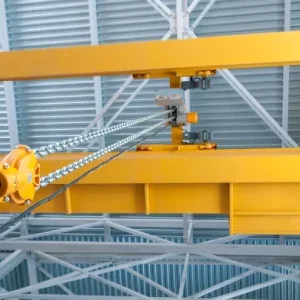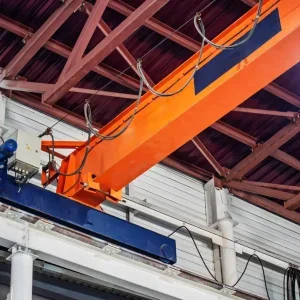Powered hoists have a duty rating and it is important that the rating is appropriate for the application. Depending upon the standard the hoist was manufactured to, the terminology may vary but essentially the duty rating is based on a combination of the frequency of use and the state of loading. The purpose of the duty rating is to ensure that the machine has an adequate reliable service life relative
to cost. A machine which operates continuously will suffer more wear than one in irregular use. One which lifts the maximum load on every occasion will wear faster than one normally
lifting only moderate loads and the occasional maximum load. Clearly a machine designed to withstand continuous working at maximum load will cost a lot more than one working at the other end of the spectrum. To get the right balance of life, reliability and cost, it is important to look in detail at these aspects of the application.
Speed
The speed of operation is another variable. A generation ago a large proportion of hoists were single speed and either too slow for high lifts or too fast for accurate positioning. Dual speed is now an option available on the majority of electric hoists and in fact some companies no longer supply single speed hoists.
If accurate positioning is required, then a dual speed electric hoist will usually be the best option. A few words of caution are necessary however. Very small movements
of the load usually require what is generally known as “inching”. To “inch” the load up or down, the operator presses the appropriate button and immediately releases it. The load moves a fraction of an inch. It works but it is not at all good for the hoist, particularly the electric motor. The motors in electric hoists have to have a high starting torque with commensurate current and therefore heating effect. They are cooled by a fan on the end of the rotor shaft. Repeated frequent starting without allowing the motor to run will cause overheating and burn the motor out.
Whilst it is difficult to completely avoid inching, a hoist with an appropriate slow speed will keep it
to the minimum and still give the accuracy of control required. But there is another factor to consider. All electric motors have a rating in terms of the amount of load they can take and for how long at a time. The motor fitted by the manufacturer will be appropriate to the duty rating of the hoist. However some hoists have a considerably lower rating on the windings for the slow speed compared to the high speed.
For these hoists, the slow speed is primarily to avoid the snatch effect that starting directly in high speed would cause and is not intended for prolonged use; rather it is just a brief step to the high speed. Indeed the usual means of control is a two stage button where the first pressure switches in slow speed and further pressure switches to high speed. So, if your application requires prolonged use at slow speed, check with the manufacturer to ensure it has the necessary rating on the low speed windings.
Height
The height of lift is another important variable. Wire rope hoists wind the rope onto a grooved drum so there is a finite limit to the length which can be accommodated. However manufacturers often offer their hoists in more than one configuration, lifting on anything from a single fall of rope to four or more. Thus, for example, a machine reeved with two falls of rope will have half the working load but twice the height of lift as the same machine reeved with four falls of rope. Special high lift versions may also be available.
In chain hoists, the chain passes over a pocketed load wheel and exits the machine on the other side so it may seem that there is no limit to the length of chain. In practice several things can limit the maximum length. As each link of chain enters or leaves the load wheel, a slight pulse occurs and, as the chain gets longer, this pulse may at some point match the natural frequency of the chain and cause a growing oscillation to occur. Furthermore, the chain is a relatively heavy lifting medium so, beyond a certain length, its extra weight has to be allowed for. If the slack side is allowed to hang freely, it can be a hazard, particularly on multi-fall blocks where for every metre of lift, two or more metres of slack chain are produced. This can easily snag when travelling or being drawn back during lowering. It is more of a hazard on power operated equipment than with hand operated because there is no feedback to the operator such as will be felt through a hand chain or lever. The normal practice for a powered chain hoist, whatever the height of lift, is to fit a chain collecting box. It is vital that this box is big enough to collect all the chain without spillage. Once any spillage occurs, rather like a siphon, all the chain will cascade out of the box at an increasing rate with the consequent danger to anyone or anything below.
Safety devices are an important feature of any power operated hoist. Within the European Union Machinery Directive, the essential health and safety requirements for power operated hoists include loading control devices to prevent dangerous movements of the load where the maximum load is not less than 1,000kg or the overturning moment is not less than 40,000Nm. As a result, new electric wire rope hoists for the European market have a load sensor device which is set a few per cent above the safe working load. Some hoists have two sensors, one set lower to trigger a warning device and the other to prevent further hoisting. Chain hoists usually employ a different method as will be explained below.
All power operated hoists need some means of limiting the hoisting and lowering motions but the methods employed vary. Modern electric wire rope hoists generally have a rope band or guide which prevents the wire rope springing off the drum under slack rope conditions. As the drum rotates this band or guide travels along the drum rather like a nut on a screw thread and operates the upper and lower limit switches. Older hoists often did not have a guide and relied on the rising hook or bottom block to trip the upper limit switch. Generally they did not have a lower limit switch so, to avoid the dangers of over-lowering, it was normal practice to ensure that the hook could touch the floor before running out of rope.
Electric
Many electric chain hoists rely upon a clutch which slips at a preset torque and comes into play when stops on the chain make contact with the body of the hoist. Although this method does not switch off the power and therefore relies on the operator to realise that the limit has been reached and release the control, it
is nevertheless very effective and
has the added value of preventing significant overload.
On other electric chain hoists,
the limits are operated by the chain mechanically engaging with a switch mechanism. Pneumatic chain hoists generally have limits operating in a similar way in conjunction with the air control valves.
The weight a pneumatic hoist can lift depends upon the air supply pressure so if this is correctly regulated, it effectively prevents significant overload. However some designs also have a spring loaded valve built into the hoist suspension. This controls the supply
of air to the motor and can be set to control the maximum load which can
be lifted.
Pneumatic hoists have many inherent safety features such as the relative safety of compressed air compared to electricity in certain environments. However the effect of the exhaust air must be considered.
In particular consider noise and whether dust or similar particles will be disturbed by it. It may be necessary to pipe the exhaust away from the area.
The environment is a factor to be considered when selecting any hoist. In a short article this cannot be dealt with in much detail but suffice to say that as well as considering the potential hazards to the environment arising from the hoist, consider also the possible effect of the environment on the hoist. In particular, extremes of heat and cold, humidity, corrosive atmospheres, exposure to chemicals, salt water etc can all have a significant affect on safety. Finally, the limitations of some older designs should be kept in mind when evaluating their suitability for current use.
Those of us who have been involved in the lifting equipment industry for many years often forget that, to the newcomer, the variety of equipment on the market can be bewildering and even somewhat intimidating, says LEEA chief executive Derrick Bailes leea 5 The basic options are a chain hoist (as shown) or a wire rope hoist, electric or pneumatic leea 2 A wire rope hoist leea 3 A JDN EN 50 pneumatic hoist in a shipyard leea 1 The Kito ED-III Series – a range of 60 to 240kg capacity dual speed cylinder control hoists. They can run on home-use power supply for single-phase operation leea 4






